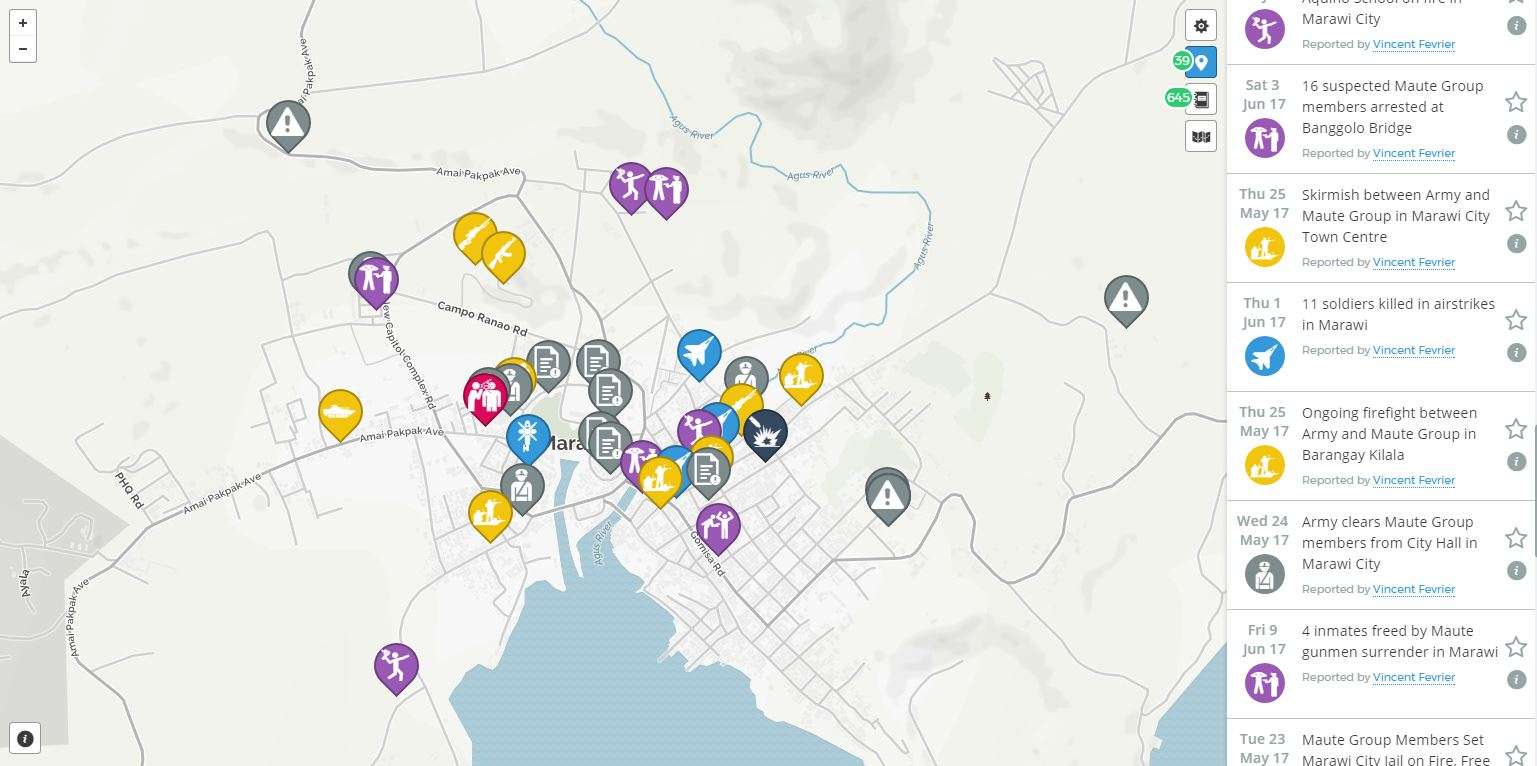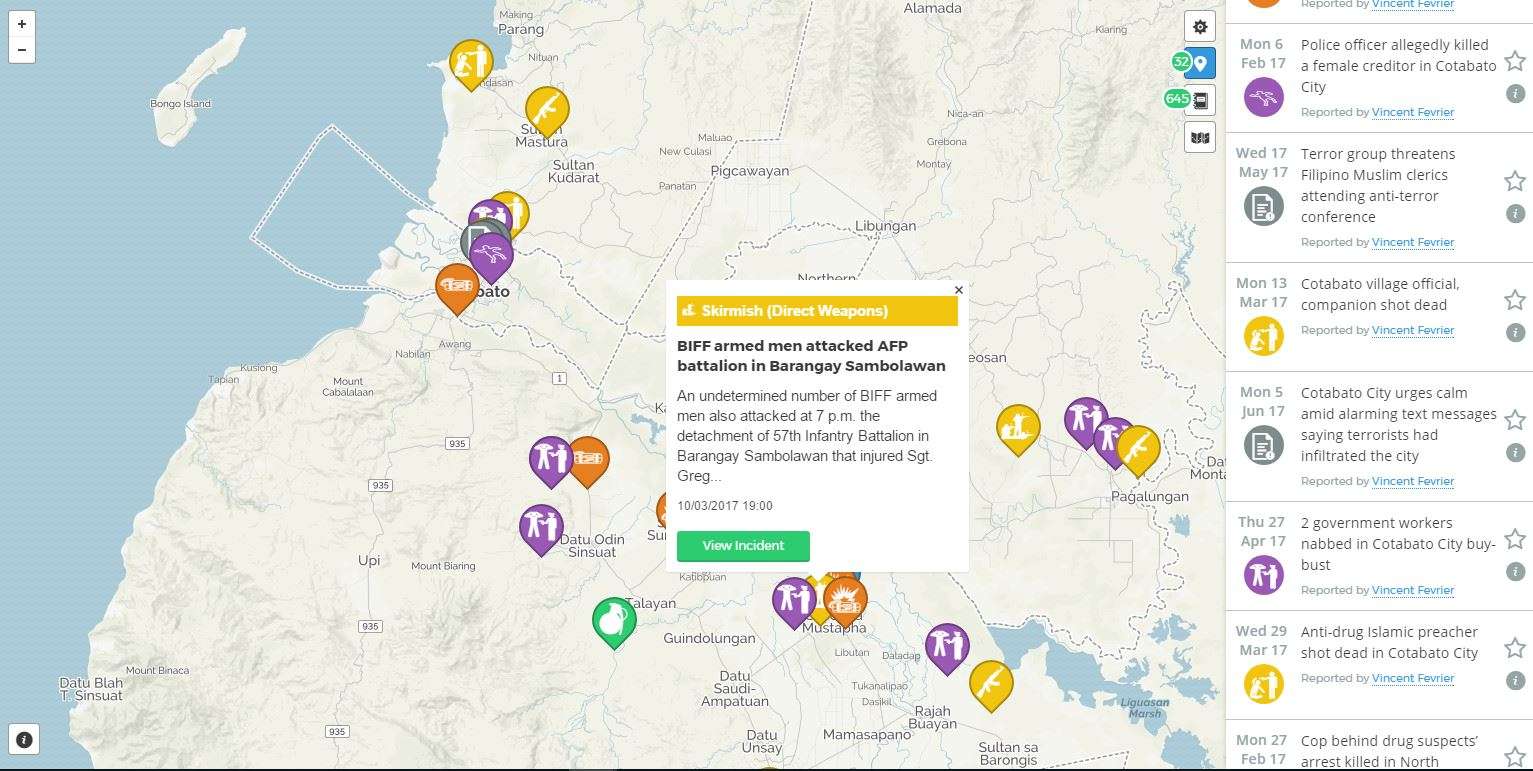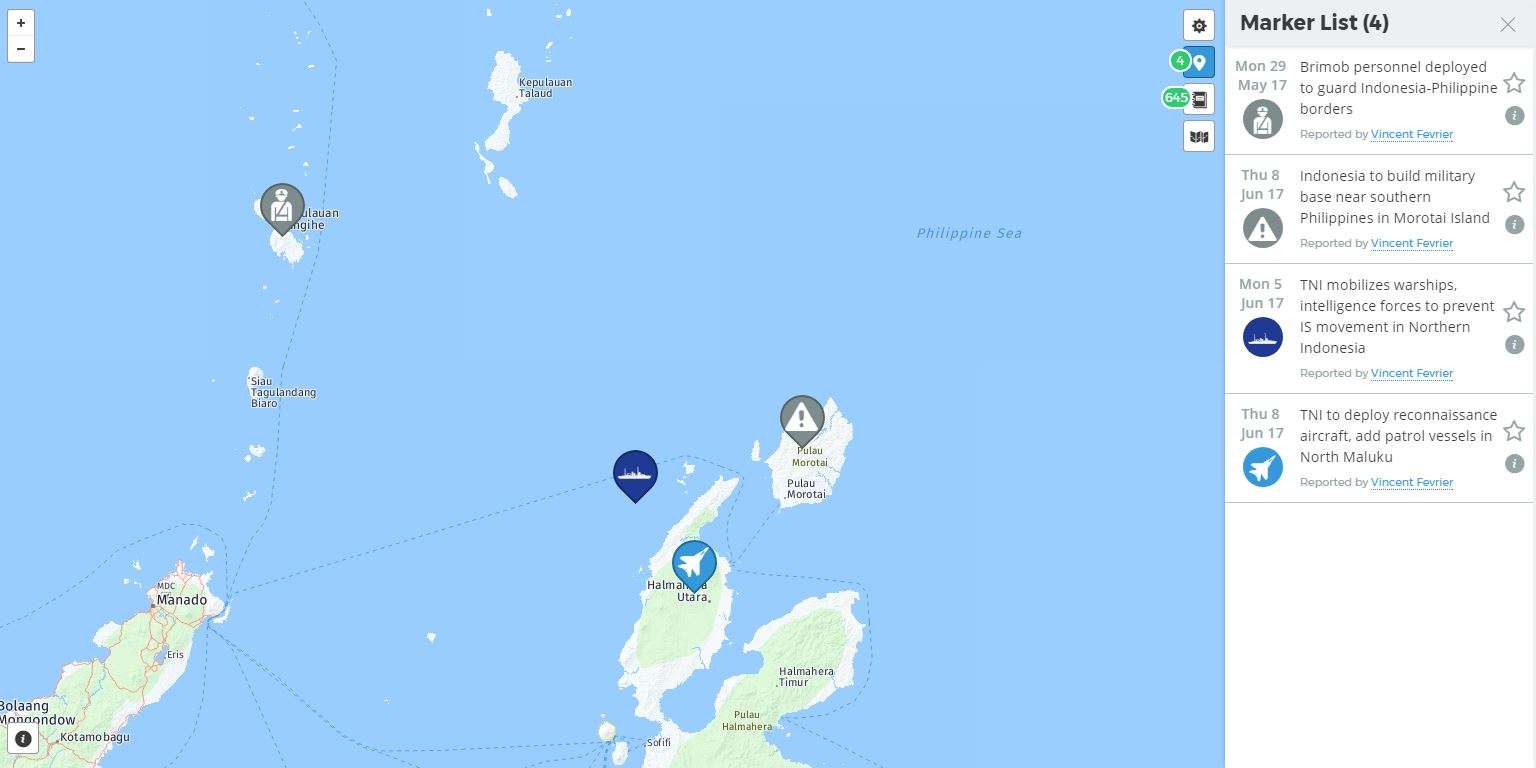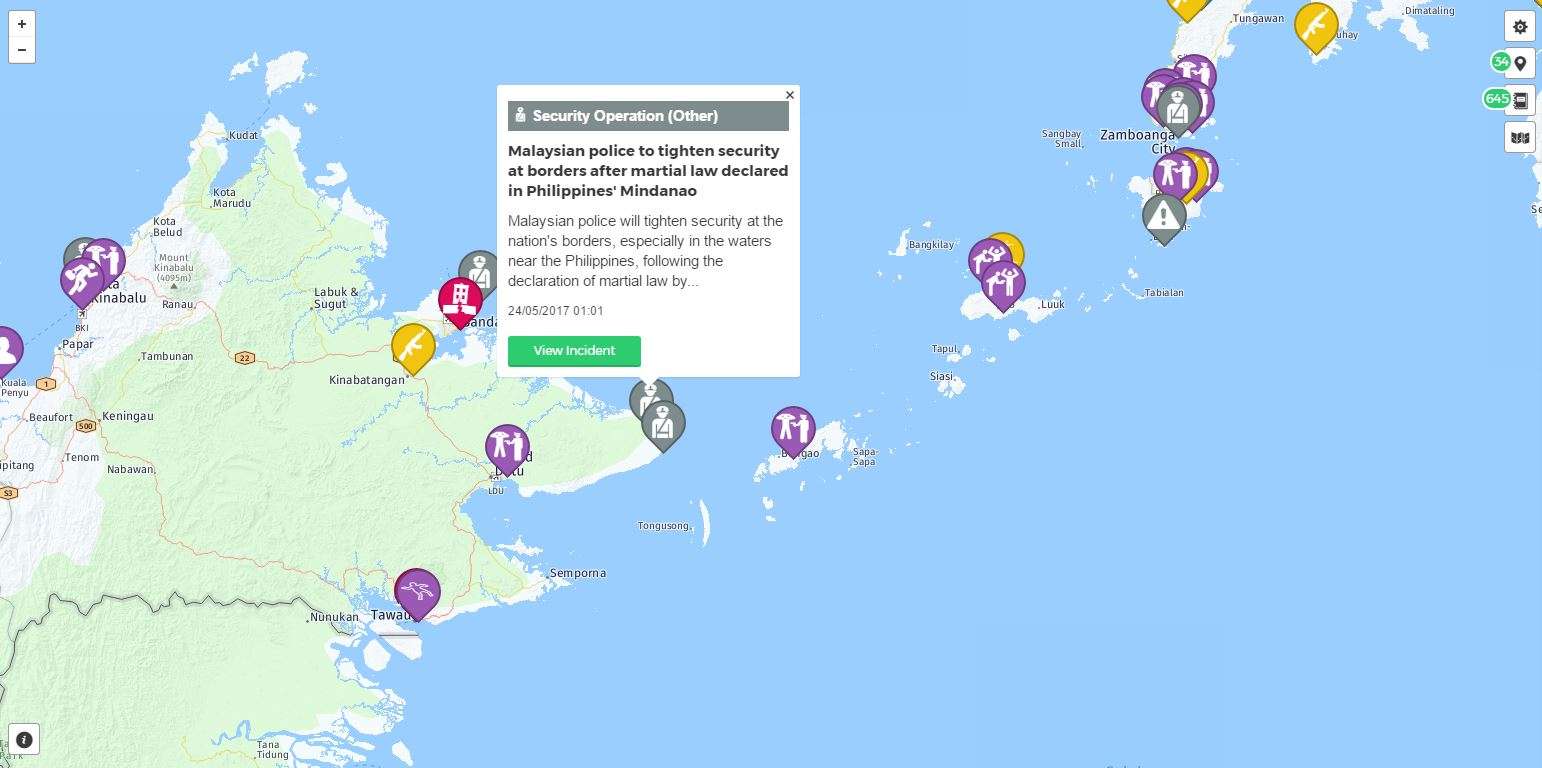The Battle for Marawi City


Incidents in Marawi City May 23rd â June 10th. (
The battle for Marawi has been ongoing for the past three weeks, and there does not seem to be a quick resolution in sight. The ordeal began on May 23rd, when a military raid on the location of Abu Sayyaf Group (ASG) leader Isnilon Hapilon in Marawi City was met with resistance, and led to an extended firefight. Hapilon who moved to Marawi City from his Abu Sayyaf stronghold of Basilan Island to join with the Maute Group, managed to escape the attack. At the same time, hundreds of fighters from the Maute Group and some from the Bangsamoro Islamic Freedom Fighters, two groups who have pledged allegiance to the Islamic State, came into the city to reinforce the ranks of the Abu Sayyaf fighters at the disposal of Hapilon. The Army Forces of the Philippines (AFP) initially described the militant force as a few dozen men, but later admitted to much larger numbers closer to 500.
In the initial hours and days of the fighting, the Maute Group ran out security forces from the city, set on fire several buildings including schools, the cathedral, and the prison, as well as stockpiling ammunition and weapons in mosques and madrasas, and hardening positions in the eastern part of the city. Much of the city’s 201,000+ inhabitants were displaced in the initial skirmishes and following air strikes from the army, but a few thousand civilians remain trapped in the city in the areas of Maute Group control. The following days, and still ongoing now, has been urban warfare between army troops and bunkered down Maute Group fighters, as well as a bombing campaign that has destroyed large swathes of central Marawi City. The battle has now become protracted with militants settled in neighborhoods of eastern Marawi City and settling in for the long term. The Army though, is confident is will rid the city of militants through air strikes and street level skirmishes, but the toll on the city’s infrastructure will be high, and may see civilians still trapped or held hostage be killed as collateral damage.
Analysis
Some media reports seem surprised of the duration of the battle and the size of the group of militants engaging in the fighting with the armed forces, yet the threat of Islamist militants is not something new to the Philippines or the region, and while the numbers can never be fully confirmed, the existence of large numbers of fighters split between various militant groups, from Abu Sayyaf with strongholds in the Sulu Archipelago to Bangsamoro Islamic Freedom Fighters (BIFF) in Maguindanao, is known. This surprise may come because since the start President Duterte’s term, the focus has primarily been on his War on Drugs which has often been focused in Metro Manila, and the northern provinces. While that has been occurring, military operations have been ongoing in Mindanao particularly against Abu Sayyaf in the Sulu Archipelago, and NPA positions who have been fighting with the government since the end of January when a peace deal fell through. The focus on these groups have allowed smaller entities like the Maute Group and the Bangsamoro Islamic Freedom Fighters to recruit and fortify their positions in their areas of control in Lanao del Sur and Maguindanao.
This isn’t the first encounter between the Maute Group and the AFP in 2017. Towards the end of January, military operations were launched in Butig Municipality in Lanao del Sur, a stronghold of the Maute Group, against the same elements of Abu Sayyaf and the Maute Group that are currently fighting in Marawi City. The operations then were also undertaken because of information regarding the whereabouts of Isnilon Hapilon, the leader of Islamic State forces in the Philippines. The AFP were unsuccessful in the operations then, as they are so far today.
The Maute Group, the entity most involved in the fighting in Marawi City was formed in 2012 by the Maute brothers, and are made up of former Moro Islamic Liberation Front (MILF) and foreign fighters. The group pledged allegiance to the Islamic State in 2015. It is believed some of their grievances stem from the peace process between the government and MILF. In 2014, a peace agreement was struck between the government and the Moro Islamic Liberation Front. The agreement would see the guerillas turning over their weapons to a third party, while in return an autonomous area for the Moro would be established in 2016 with a new regional police force created to keep order. Additionally, the Filipino army would reduce its presence in the area, and help disband private armies in the area.
The Bangsamoro Basic Law, which is written to establish the autonomous political entity known as the Bangsamoro Autonomous Region, which would replace the current Autonomous Region in Muslim Mindanao, was proposed in 2014 under the peace agreement between the government and MILF, but has yet to pass. Public opinion for the law fell in 2015 after the Mamasapano clash which resulted from the Army launching an operation in MILF territory without proper coordination, and resulting in the deaths of 44 government soldiers, 18 MILF, and 5 BIFF. The Maute Group has used the lack of implementation of the law as a recruitment tool, particularly to attract easily manipulated youth. The lack of movement on the Moro getting autonomy has frustrated many groups in the region, and until such issue is tackled, insurgency will continue.
Working With Other Groups to Resolve the Crisis
On June 9th, a report by the news outlets brought to light the involvement of the U.S. armed forces in supporting the AFP in retaking the city of Marawi. The report says that U.S. special forces were assisting the AFP in a technical capacity, and were not themselves fighting. On June 11th though, reports came out quoting President Duterte as not being aware of U.S. assistance in the fight against the Maute Group, saying that he “never approached the U.S.” for help. It was only in September 2016 that President Duterte had called for U.S. Special Forces to leave the southern islands of the Philippines, saying that their presence could complicate the Philippines’ operations against islamist militants. The U.S. has had a presence in the southern Philippines since 2002, particularly in providing support in the fight against Abu Sayyaf, but that program was discontinued in 2015, and since then the presence of U.S. forces has only been for a logistic and technical support role. The support of the U.S. in retaking Marawi City may be a future issue for groups such as MILF, MNLF, and the NPA.
In late May, President Duterte appealed to MILF, MNLF, and the NPA to fight extremists in their areas, yet later withdrew plans for some of their fighters joining the fray. In early June as well, President Duterte turned down the offer from the CPP to have the NPA fight extremists in Marawi. This is due to stalled peace talks between the NPA and the government, and the lack of a unilateral ceasefire between the two groups which makes coordination and collaboration difficult decision to undertake. On June 7th, President Duterte put on hold plans to allow 2,000 fighters of the Moro National Liberation Front (MNLF) to help in the fight to retake Marawi City from the Maute Group. Although President Duterte did not take the offer to have MILF, MNLF, and NPA fighters to join against the Maute Group, the government has coordinated with the MILF to establish a peace corridor in order to evacuate civilians still trapped in areas where the Maute Group are holed up. As of June 11th, over 220 civilians have been rescued through this corridor.
The use of U.S. Special Forces, even if just in a technical capacity, may have a detrimental effect regarding the sentiments of insurgent and terrorist groups in Mindanao. When discussing the use of U.S. forces in the fight against the Maute Group, the national chairperson of Suara Bangsamoro, “said unless the Philippines end “subservience” to the “US War on Terror”, problems of terrorism in Mindanao, like the Maute and ASG will continue.” He added, “The Philippines’ subservience to US causes us trouble aside from violating the country’s sovereignty. It is the US which brings terrorism here like the US-CIA that created ISIS and which is now linked to the Maute group and the ASG.” This kind of rhetoric shows the disdain groups in the region have for the U.S., and is similar to rhetoric and goals of groups such as the NPA who want the United States out of the Philippines. While President Duterte has said he is not aware of the U.S.’ role in the military operations in Marawi City, he must tread lightly in his relationships with not only the U.S., but also with the various insurgent groups to which he has reached out and vice versa. The effects of the U.S. presence and involvement in Mindanao and Marawi City, my be seen after the crisis is over, through an increase in the number of attacks groups such as the NPA undertake against government targets.
Threats in Surrounding Areas
Movement by militants in other parts of the country such as Maguindanao and Sulu are stretching the military thin, and therefore if coordinated large scale attacks were to take place it could create havoc. This can be seen with a recent skirmish in Mamasapano where militants of the Bangsamoro Islamic Freedom Fighters attacked a detachment of the Army, as well as several NPA attacks in South Cotabato, Misamis Oriental, and Samar. Additionally, a couple of militants belonging to the Maute Group and Ansar Al-Khilafa were arrested in Cotabato City, while two militants were arrested in Datu Odin Sinsuat in possession of several weapons including five M-16 rifles, a .50-cal Barret sniper rifle, and a .30-cal M2 carbine among others. With the intelligence gathered and the arrests made, it was believed that another attack was planned for Cotabato City like that of Marawi City, to spread military resources thin.


Incidents around Cotabato City including the clash between government forces and BIFF members (Click on above image to expand).
The attack on Marawi City has shown the reach certain groups have within the region. With fighters believed or proven to have come from Indonesia, Malaysia, and other countries within the region, it has shown that the ideology is exportable, and that the free movement of militants is an issue that needs to be addressed by all regional powers. The number of foreign fighters within the ranks of the Maute Group reinforces the fear that with the Islamic State losing territory in Iraq and parts of Syria, that militants will turn to South East Asia as the location for establishing a caliphate, and without the resources that the international community is pouring into the Middle East, a stronghold could well be implemented, particularly in Mindanao.
What has regional powers done to combat it
The crisis in Marawi has sent a clear message to the Philippines’ neighbors that the Islamic State, through its local groups who have pledged allegiance, have the capacity to launch large scale attacks. This threat has prompted countries like Indonesia and Malaysia to undertake new security measures. At the beginning of June, the Philippines along with Indonesia and Malaysia announced they would be undertaking joint air patrols starting on June 19th, to go along with their joint maritime operations in the Sulu Sea to stem the flow of militants between the countries. Militants have been able to travel between the countries due to corruption and porous borders which are vast and hard to monitor.
On May 29th, Indonesia launched Operation Aman Nusa 3. This operation is in direct response to the threat posed by the situation in Marawi City in the Philippines, and would serve to secure the border between the two countries with a deployment of hundreds of Mobile Brigade personnel who would carry maritime patrols, monitor mass organisation activities, intelligence gathering, and coordinate with Densus 88 to monitor any radical elements within the areas of Sangihe and Talaud Islands. On June 6th, Densus 88 in Yogyakarta arrested a suspected terrorist believed to have helped Indonesians travel to Mindanao, where they joined up with groups affiliated to the Islamic State, who are currently in control of parts of Marawi City. On June 8th, the Indonesian Military Commander General Gatot Nurmantyo announced that the country would build additional military bases, some on islands bordering the Philippines such as Morotai Island in North Maluku. Additionally, on the same day, the General announced the dispatch of a Boeing reconnaissance aircraft to North Maluku, which will be used to monitor movements in the province, and combined with maritime patrols, would strengthen resources to stop militants from infiltrating Indonesia from the Philippines and vice versa.


Indonesiaâs response to the crisis in Marawi City. (Click on above image to expand).
Malaysia, on their end, have placed Army troops in Sabah on the border with the Philippines, due to the threat of the current situation in the Philippines. While troops have been deployed there, Malaysia has also placed troops on their northern border with southern Thailand, as an insurgency there also poses a threat, and in May was where a suspected leader of an Islamic State cell had fled before surrendering later in Kelantan.

Malaysia â moving security forces to Sabah on the border with the Philippines
This shows a more serious response by the neighboring countries to an event occurring in the Philippines. They have responded to events before, usually with increased maritime patrols due to Abu Sayyaf kidnappings in the Sulu and Celebes Seas, but this time a larger number of resources are being put in place to combat the threat of the Islamic State from the Philippines, and from the region as a whole.
The Armed Forces of the Philippines will retake Marawi City from the Philippines. It is only a matter of time before the militants are defeated in this battle, but this is not to mean that it will rid the region of the Maute Group or quash the insurgencies. What will need to be observed closely is how President Rodrigo Duterte will use Martial Law after the city is retaken. Will he ask for an extension to it on the grounds of furthering security in the region, but use it to attempt to make gains against other insurgent groups in Mindanao such as the Bangsamoro Islamic Freedom Fighters and the New People’s Army? Only time will tell, as the effects of the crisis will not be fully known until after the battle has ended. In the meantime, it is important the government not only rid Marawi City of the militants, but also ensure a well planned and well funded response to the needs of those displaced. Currently, the surrounding areas of Marawi City are facing a humanitarian crisis with the number of displaced persons, and if the government does not meet the immediate needs of the people, along with their needs once they’re able to return to their homes, it may provide another tool for recruitment for terrorist elements in the surrounding areas using discontent against the government to fuel the flames of conflict.
